ニュース
243件のニュース / 2021年
-
2021-03-25
ホットトピック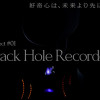
Exhibition of "Black Hole Recorder"
At the National Museum of Emerging Science and Innovation (Miraikan) located in Tokyo, iTHEMS exhibition of "Black Hole Recorder" was held last week (March 14-15, March 17-21). Details of this outreach activity (Black Hole Recorder) and the general concept behind (UselessPrototyping Studio) can be seen from the URLs below.
-
2021-03-25
セミナーレポート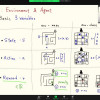
Information Theory SG by Dr. Akinori Tanaka on March 24, 2021
On 24th March, Dr. Akinori Tanaka gave an introduction to the reinforcement learning (RL) in our journal club of the Information Theory Study Group. He started from simple examples of a maze and a chess game to introduce the fundamental variables (i.e., states, actions, and rewards) and their evolution as a Markov decision process.After explaining that the goal of the RL is to maximize the value function, he discussed policy improvement theorem with the application to the epsilon-greedy update. We thank Akinori for the great and clear talk!
-
2021-03-18
セミナーレポート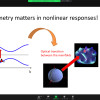
Quantum Matter Seminar by Prof. Takahiro Morimoto on March 16, 2021
On March 16th, Prof. Takahiro Morimoto from the University of Tokyo gave an online talk on geometric nonlinear optical effects. First, he introduced topological states of matter and the notion of the Berry connection to the audience. He explained how these concepts lead to the quantization of observable quantities in the linear-response regime so that the audience learned the background to understand his main research works. After the introduction, he talked about several geometric nonlinear effects in topological states beyond the linear response theory. In particular, the shift current stems from the geometric nonlinear response, and the quantized circular photogalvanic effect can be realized in specific Weyl semimetals. In addition to the theoretical concepts, he also discussed experimental observations, such as perovskite-based solar cell materials and chiral multifold fermion compound RhSi. During and after the talk there were interactive discussions, and more than 25 participants attended this well-presented talk. Reported by Chen-Hsuan Hsu (CEMS, RIKEN) and Ching-Kai Chiu
-
2021-03-16
受賞情報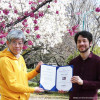
Dr. Jeffery Fawcett received 12th annual RIKEN Research Incentive Award (Ohbu Award)
Jeffery Fawcett received "FY2020 Researcher Incentive Award (桜舞賞)" on March 17, 2021 for his achievements in the "Study of genome evolution using large-scale genomic data". Congratulations!
-
2021-03-12
プレスリリース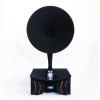
ブラックホールを情報ストレージとして一人一個持ち歩ける未来が来るかもしれない?
Useless Prototyping Studio第1弾プロトタイプ「Black Hole Recorder」完成 科学的理論を元に空想し、未来の情報ストレージデバイスをプロトタイピング。 ―3月14日(日)~21日(日)まで日本科学未来館にて期間限定特別公開― 一見役に立たないプロトタイプで、未知への好奇心が未来をつくる可能性を可視化する「Useless Prototyping Studio」(ユースレス・プロトタイピング・スタジオ)は、第1弾プロトタイプとして、未来の情報ストレージデバイス「Black Hole Recorder」(ブラックホール・レコーダー)を制作しました。また、本日3月12日公開の特設サイトにてその概要や、背景情報などを公開します。さらに、一般の皆様にご覧いただける機会として、ブラックホールの基礎理論を構築した2名の科学者、アルベルト・アインシュタインの誕生日であり、スティーブン・ホーキングの命日である3月14日(日)から、東京都江東区の日本科学未来館にて「Black Hole Recorder」を期間限定で特別公開します。 Black Hole Recorderは、ブラックホールを制御し、情報を蓄積できるデバイスとして利用する未来を見据えて開発された、ブラックホールストレージのプロトタイプ(模型)です。蓄音機をモチーフに、膨大なデータを録音することができるデバイスという設定です。また大容量の情報を蓄えるだけでなく、取り込んだ情報を取り出すことも可能です。人間は、数千年前に文字を発明して以降、情報を記録する媒体と技術を紙・印刷・写真・蓄音機・映像・データと進化させてきました。近年、どれだけ大量の情報を蓄えられるかの開発がされています。そして将来、ブラックホールを情報ストレージとして活用し、ポケットに入れて持ち運ぶ時代の可能性が考えられます。
-
2021-03-12
ホットトピック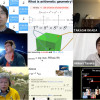
iTHEMS NOW & NEXT FY2020 was held on March 11, 2021
The annual in-house gathering entitled iTHEMS NOW and NEXT FY2020 was held on March 11th via zoom. The gathering is the occasion we share the current status and future perspectives on our research and organization. In the morning, keynote overview talks were given by Takashi Okada, Hiroyasu Miyazaki, Akinori Tanaka, and Ching-Kai Chiu, followed by the interdisciplinary talk which Don Warren and Catherine Beauchemin jointly presented. During subsequent lunchtime, a special session on the proper practices in conducting scientific researches was taken place. In the session, the participants discussed their research practices in small groups and later shared their discussions with all. The afternoon session was devoted to the progress reports from the working groups and the study groups. This time, we observed a moment of silence in honor of those affected by the 2011 Tohoku earthquake and tsunami during these presentations since it just marked precisely ten years from the calamity. Program Director Hatsuda's remarks concluded the gathering.
-
2021-03-11
お知らせ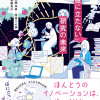
Dr. Tetsuo Hatsuda's new book, "The Future of 'Useless' Research", will be published on April 9, 2021
Dr. Hatsuda's new book, "The Future of 'Useless' Research", will be published on April 9th, 2021. It is now available for pre-order!
-
2021-03-05
セミナーレポート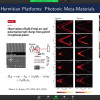
Quantum Matter Seminar by Prof. Jan Budich on March 3, 2021
We are happy to invite Prof. Han Budich from the Dresden University of Technology to give a talk on March 3rd. The topic is Exceptional Topology of Non-Hermitian Systems: from Theoretical Foundations to Novel Quantum Sensors. Prof. Budich started with the review of the topological phases. After the introduction, he introduced the emergence of the exceptional points from non-Hermitian systems. The exceptional points, which are similar to Weyl nodes, possess intrinsic topological properties. Later, he proposed a novel idea of the quantum sensor to probe topological features from non-Hermitian platforms. It is great to have this nice talk.
-
2021-03-04
今週の注目人物
Self-introduction: Yuta Sekino
I am Yuta Sekino, a JSPS fellow who joined iTHEMS on March 1, 2021. I am a theoretical physicist studying physics of ultracold atoms. My main research interest is universal properties of many-body systems as well as transport phenomena. I am currently working on atomic gases in spatially one dimension and spin transport. At iTHEMS, I hope to broaden my research horizon through discussions with researchers in various fields.
-
2021-03-04
今週の注目人物
Self-introduction: Takeru Yokota
My name is Takeru Yokota. I joined iTHEMS in March 2021. My research field is theoretical physics. I have been interested in the development of nonperturbative frameworks to describe many-body systems, such as the functional renormalization group (FRG). In particular, I have challenged to establish a new framework based on the combination of FRG and density functional theory, which is another powerful method used for various systems including nuclear systems and condensed matter systems, and involved in the application to electrons, nucleons, and classical liquids. I am looking forward to new developments of research emerged from the interaction with researchers from various fields in iTHEMS.
-
2021-03-02
ホットトピック
Biology and mathematics: What it would be like to be crazy about both
Dr. Ryosuke Iritani (Research Scientist, iTHEMS) writes frankly on the website SURI-JOSHI about why he chose his current field. Don't miss it!
-
2021-03-02
ホットトピック
オンライン座談会「『役に立たない』科学が役に立つ」開催レポート
昨年8月22日、アカデミストと理化学研究所数理創造プログラムは、これからの基礎研究のありかたについて議論することを目的に「初田哲男×大隅良典×隠岐さや香 オンライン座談会 ~「役に立たない」科学が役に立つ~」を開催しました。当日のオンライン座談会の様子は関連リンクをご参照ください。
-
2021-03-01
リサーチニュース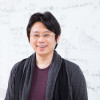
RIKEN Research: Supernova had a missing companion star
The massive star that exploded to form the supernova known as Cassiopeia A most likely had a companion star that has yet to be spotted, a spectro-scopic analysis by RIKEN astro-physicists suggests.
-
2021-03-01
リサーチニュース
RIKEN Research: RIKEN and JAXA collaborate on real-time rainfall forecasts
Researchers from RIKEN, Chiba Univer-sity, the University of Tokyo and the Japan Aerospace Exploration Agency (JAXA) have used a combination of satellite data and supercomputer simulations to offer five-day rainfall forecasts over the Internet covering the globe. Dr. Takemasa Miyoshi (iTHEMS/R-CCS) commented in the article.
-
2021-02-26
セミナーレポート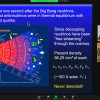
ABBL-iTHEMS Joint Seminar by Prof. Gordon Baym on February 22, 2021
On Feb. 22, our iTHEMS colleague, Gordon Baym, gave an online talk from Urbana-Champaign on the detection of the primordial neutrinos created in the early Universe. We are in the sea of those neutrinos at the present day with the neutrino density of about 56/cc for each neutrino species. Although neutrinos (anti-neutrinos) are left-handed (right-handed) in early Universe, both cosmic and galactic magnetic fields as well as the gravitational inhomogeneities can flip their spins with respect to the momentum, so that the helicities (spin projection along the direction of the momentum) of the relic neutrinos could be a new probe of cosmic gravitational and magnetic fields. More that 60 participants attended this interesting seminar and there were lively discussions during and after the talk.
-
2021-02-25
セミナーレポート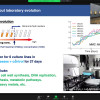
Biology Seminar by Mr. Junichiro Iwasawa on February 18, 2021
On 18th February, we invited Junichiro Iwasawa from the University of Tokyo, who gave a talk about the unique study to identify the evolutionary constraints of drug-resistance in Escherichia coli using automated high-throughput laboratory experiments. He first talked about the background of drug resistance evolution and about the well-known / novel resistance-conferring genes for E. coli that were elucidated from their data. He then moved on to the details of the data analyses and explained the combined method of random forest regression and principal component analysis on the multi-omics data. We enjoyed a long discussion on every single detail of the impressive work. We especially thank him for accepting our invitation despite the tight schedule with his dissertation. Thank you again for the great talk! -Ryosuke Iritani
-
2021-02-25
セミナーレポート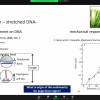
Biology Seminar by Dr. Hiroshi Yokota on February 25, 2021
In iTHEMS biology seminar on Feb. 25th, Dr. Hiroshi Yokota (iTHEMS) talked about the mechanism of the non-linear response of DNA under stretching force. In the introduction part, he mentioned the experimental technique using the magnetic tweezer to measure the extension of DNA under stretching force, and he also showed the experimental results of the non-linear response of DNA. He then explained the strategy to clarify the origin of non-linearity by applying mathematical modeling and statistical physics. Introducing the worm-like chain model, he transformed the Hamiltonian in an elegant way and analytically obtained the formula of the extension, which explains the experimental data. His description of the model was very clear, and there were many questions and discussions. We are thankful to Hiroshi for the intriguing talk. Kyosuke Adachi
-
2021-02-24
プレスリリース
Press Release from Chandra, NuSTAR and INAF on 34th Happy Birthday of SN1987A
The paper "Indication of a Pulsar Wind Nebula in the hard X-ray emission from SN 1987A" by Dr. Shigehiro Nagataki (Deputy Program Director, iTHEMS), Dr. Masaomi Ono (Research Scientist, iTHEMS) and Mr. Akira Dohi (Junior Research Associate, iTHEMS) was published in the NASA and INAF press releases on February 23, 2021 (SN1987A's 34th birthday!). The following is a message from Dr. Nagataki; "We detected high-energy X-rays by NuSTAR, which are likely to come from activities of pulsar wind nebula of SN1987A (it has been a big mystery why the neutron star in SN1987A has not been detected for 34 years since Prof. Koshiba et al. detected neutrinos at the birth of proto-neutron star in SN198A). Our paper will be published by Astrophysical Journal Letters this week."
-
2021-02-19
セミナーレポート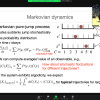
Information Theory SG by Dr. Ryusuke Hamazaki on February 17, 2021
On 17th February, we had Ryusuke Hamazaki (from RIKEN Hakubi and iTHEMS) talking about the recent studies on the large deviation principle in our journal club of the Information Theory Study Group. He started off by demonstrating Bernoulli's process and how to compute the large deviations, and then defined the Level 2.5 large deviations in Markovian jump process, thereby providing the derivation of a recently proposed inequality (the thermodynamic uncertainty relation). Finally, he explained possible extensions to quantum systems. The talk received numerous questions in every single part, specifically from those interested in the derivation and application of the Level 2.5 large deviation. Thanks, Ryusuke, for the great and inspiring talk! Ryosuke Iritani (iTHEMS)
-
2021-02-17
セミナーレポート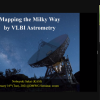
DMWG Seminar by Dr. Sakai: Astrometory for DM search
The precise understanding of the local DM density, as well as its velocity distribution, is critical for dark matter (DM) search, especially for direct detection experiments. We need information about the global structure such as the position and rotation velocity of the Solar system when evaluating these quantities. Astrometry, which is a technique to measure the time dependence of the position of stars, powerfully probes the 3D gravitational structure of our Galaxy. There are two types of astrometric observations: the first one is based on optical (and infrared) photometry. The parallax is obtained by comparing two snapshots of the sky between two epochs. The Gaia mission is the representative for this kind of observation. Gaia reveals the structure of our Galaxy up to ~5kpc from the Sun. The mission is planned to continue the observation to extend our reach to ~10kpc, meaning that it should cover the Galactic Center in the near future. The second one is the VLBI observation. VLBI is an abbreviation of the very-long baseline interferometry. The spatial resolution of milli-arcsecond is achieved with VLBI techniques. However, the sensitivity is limited and long-lasting observations are required in general. In this sense, VLBI and optical photometry are complemental. One important discovery for DM search from VLBI astrometry is reported in this seminar. The VLBI observation of the Galactic disk region reveals the position of the Sun is closer to the Galactic Center compared to the conventional values used for a long time, and the rotation velocity is higher. This means that our Galaxy is heavier, i.e. contains much DM, and the relative velocity between DM particle and us is different, compared with the previous estimates. Also, the disk region does not reach the equilibrium yet. These facts should change the picture of our Galactic DM structure. New facilities for astrometric observations are now being planned and constructed. There are diverse possibilities for the synergy between DM search. The astrometry should give important indications such as the merger history of DM halo, dynamical interaction between the Milky Way and its satellite galaxies, the global structure of the Milky Way, and far more. We should stay tuned!
-
2021-02-17
セミナーレポート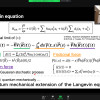
iTHEMS Theoretical Physics Seminar by Mr. Masaaki Tokieda on February 16, 2021
On February 16, the iTHEMS-phys seminar entitled "Quantum mechanical description of energy dissipation and application to heavy-ion fusion reactions" given by Mr. Masaaki Tokieda (Tohoku U.) was held. He introduced his work during graduate school, that is, considering dissipation and fluctuation to the quantum mechanics to unify the description of above the Coulomb barrier and sub-barrier reactions. He also applied the method to heavy-ion fusion reactions. The seminar was held via the Zoom online conference systems. More than 20 people, including outside from iTHEMS, attended the seminar. The discussion was quite lively, and it was continued for long, even after the seminar.
-
2021-02-15
セミナーレポート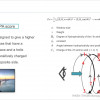
Biology Seminar by Dr. Keitaro Kume on February 12, 2021
In iTHEMS biology seminar on February 12, Keitaro Kume (Univ. of Tsukuba) gave us a talk about applying machine learning to the analysis of non-model organisms that are difficult to experiment with. First, Dr Kume introduced us about the brief mitochondrial evolution and several eukaryotes possessed not typical mitochondria as like Mitochondrion related organelle (MRO) which is highly degraded mitochondria. Next, he described the detection of mitochondrial localization signals and their applications, explaining that it is difficult to detect localization signals in mitochondria of non-model organisms, especially MROs. Finally, He obtained a large amount of data on MRO-localized proteins in non-model organisms, and through machine learning using the data as training data, he created a detector that can detect MRO-localized signals in such non-model organisms. He presented a good example of the connection between biological evolutionary research and machine learning, which led to a lively discussion at the seminar. Thank you very much, Kei!
-
2021-02-10
今週の論文Week 2 of February
Title: Quiescent luminosities of accreting neutron stars with different equation of states Author: Helei Liu, Akira Dohi, Masa-aki Hashimoto, Yasuhide Matsuo, Guo-Liang Lü, Tsuneo Noda arXiv: http://arxiv.org/abs/2102.04012v1 Title: An adjunction inequality for the Bauer Furuta type invariants, with applications to sliceness and 4-manifold topology Author: Nobuo Iida, Anubhav Mukherjee, Masaki Taniguchi arXiv: http://arxiv.org/abs/2102.02076v1
-
2021-02-10
プレスリリース
ネットワーク上の情報の流れをダイアグラムで表現する新理論を開発!
九州大学数理・データサイエンス教育研究センター/芸術工学研究院の森史助教と理化学研究所(理研)数理創造プログラムの岡田崇上級研究員の研究チームは、ブーリアンネットワーク上の情報の流れをダイアグラムに基づいて展開する新しい理論を開発しました。 詳細は関連リンクをご覧ください。
-
2021-02-08
リサーチニュース
RIKEN NEWS: 宇宙の物質進化を追う ─ 原子核から原子・分子へ
理研内で「宇宙における物質進化 ─ 原子核・原子・分子・その先へ」と題したプロジェクトが2019年度から5年計画で進行している。開拓研究本部の坂井星・惑星形成研究室、玉川高エネルギー宇宙物理研究室、長瀧天体ビッグバン研究室が核となり、理研内外の研究者が集結。物理と化学が融合した新しい宇宙研究を実現し、原子核から原子、分子へと至る物質進化をつなげて理解することを目指す。
-
2021-02-05
セミナーレポート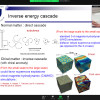
iTHEMS Theoretical Physics Seminar by Dr. Di-Lun Yang on February 4, 2021
On February 4, the iTHEMS-phys seminar entitled "Quantum kinetic theory for chiral and spin transport in relativistic heavy ion collisions and core-collapse supernovae" given by Dr. Di-Lun Yang (Keio U.) was held. He has been working for the quantum kinetic theory. In his seminar, first, he introduced the general background of the quantum transport of the massless fermions and its anomaly. Then, he showed its application to the relativistic heavy-ion collisions and core-collapse supernovae. The seminar was held via the Zoom online conference systems. More than 20 people, including outside from iTHEMS, attended the seminar. The discussion was quite lively, and it was continued for long, even after the seminar.
-
2021-02-05
セミナーレポート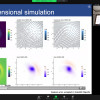
Biology Seminar by Mr. Yoshifumi Asakura on February 4, 2021
In iTHEMS Biology Seminar on Feb. 4th, Yoshifumi Asakura (Kyoto University) talked about modeling of the mechano-chemical dynamics of an epithelial sheet. He first reviewed experimental observation of the epithelial sheet dynamics with ERK signals and simple theoretical modeling of the mechano-chemical dynamics. He then presented the main questions, stressing the importance of two-dimensionality and parameter heterogeneity in tissue dynamics. In the method part, he introduced the hierarchical modeling which connects the particle-based and continuum models with the cell tracking data. He showed that the models can reproduce the essential features of the tissue dynamics with ERK signals, and moreover, can be used for the quantitative prediction of the velocity field of cells. His presentation contained many beautiful movies of the epithelial sheet dynamics and model simulations. We are thankful to him for the nice talk! Kyosuke Adachi
-
2021-02-04
今週の論文Week 1 of February
Title: Twisted crystallograpic T-duality via the Baum--Connes isomorphism Author: Kiyonori Gomi, Yosuke Kubota, Guo Chuan Thiang arXiv: http://arxiv.org/abs/2102.00393v1 Title: Most charming dibaryon near unitarity Author: Yan Lyu, Hui Tong, Takuya Sugiura, Sinya Aoki, Takumi Doi, Tetsuo Hatsuda, Jie Meng, Takaya Miyamoto arXiv: http://arxiv.org/abs/2102.00181v1 Title: Time to revisit the endpoint dilution assay and to replace TCID50 and PFU as measures of a virus sample's infection concentration Author: Daniel Cresta, Donald C. Warren, Christian Quirouette, Amanda P. Smith, Lindey C. Lane, Amber M. Smith, Catherine A. A. Beauchemin arXiv: http://arxiv.org/abs/2101.11526v1
-
2021-02-04
プレスリリース
多くのブランドが多くの手段を駆使する複雑な市場競争を理解する
明治大学商学部 水野誠教授らの研究グループ(理化学研究所数理創造プログラム 青山秀明客員主管研究員等)が経済物理学から生まれた新手法をマーケティングデータに適用する方法を開発しました。 詳細は、関連リンクをご覧ください。
-
2021-02-04
今週の注目人物
Self-introduction: Björn Ahlgren
My name is Björn Ahlgren. I joined iTHEMS as a visiting scientist in February 2021 as part of my current postdok, and I'm otherwise based at KTH in Stockholm, Sweden. My field of research is astrophysics, where I work mainly on gamma-ray bursts (GRBs), which are some of the most violent explosions in the Universe. These phenomena are caused by the collapse of particularly massive stars, and by compact object binary mergers, and they can serve both as laboratories for physics under extreme conditions, as well as probes of the early Universe. In my research I focus on the intersection between theory and observations, where I try to develop and reconcile theoretical models for the emission mechanisms of GRBs with the best available observations, using statistical methods. My specialisation lying in applied statistics, I really enjoy interdisciplinary projects where I get to work with new ideas and new data. I'm excited to join iTHEMS and I hope I will get the opportunity to engage in new collaborations across different disciplines.
-
2021-01-29
セミナーレポート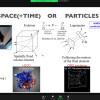
iTHEMS Theoretical Physics Seminar by Prof. Nobutoshi Yasutake on January 28, 2021
On January 28, the iTHEMS-phys seminar entitled "Many body problems from quarks to stellar evolutions" given by Prof. Nobutoshi Yasutake (Chiba Institute of Technology/JAEA) was held. He has been working for the stelar evolutions as gravitational many-body problems and the hadronic matter as quantum many-body problems based on the Lagrangian schemes. Recently, he discussed hadronic matters properties using the color molecular dynamics. The seminar was held via the Zoom online conference systems. Around 20 people, including outside from iTHEMS, attended the seminar. The discussion was quite lively, and it was continued more than one hour even after the seminar.
-
2021-01-28
今週の論文Week 5 of January
Title: Drifting Dirac monopole in Berry's phase Author: Kazuo Fujikawa, Koichiro Umetsu arXiv: http://arxiv.org/abs/2101.10541v1 Title: Deconfining Phase Boundary of Rapidly Rotating Hot and Dense Matter and Analysis of Moment of Inertia Author: Yuki Fujimoto, Kenji Fukushima, Yoshimasa Hidaka arXiv: http://arxiv.org/abs/2101.09173v1
-
2021-01-28
セミナーレポート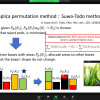
Information Theory SG by Dr. Hiroshi Yokota on January 27, 2021
Today's journal club of the Information Theory Study Group had Hiroshi Yokota (iTHEMS) talk about the replica-permutation method to obtain stable structures. He started off the talk with some introduction of proteins' stable structures. To avoid reaching nonglobally optimal structures, the replica-exchange method used to be applied; however, this method may be computationally expensive and less efficient in some circumstances. Later work has proposed the replica-permutation method by which the candidates of the stable structures are permutated (shuffled) and relaxes the detailed balance condition. He drew an analogy with allocation problems of various volumed cups each filled with water. He finally talked about the application in a paper that examines amyloid ? oligomerization. The audience asked lots of questions about the algorithm per se, physical meaning, and even its potential applications. Thanks, Hiroshi, for the fantastic talk! I as well as arguably all the audience really enjoyed it! -Ryosuke Iritani (RIKEN iTHEMS)
-
2021-01-25
セミナーレポート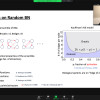
Biology Seminar by Dr. Takashi Okada on January 21, 2021
On January 21st, Takashi Okada (RIKEN iTHEMS) gave a talk on Boolean networks at the iTHEMS Biology Seminar. He first introduced the basics of Boolean networks and their applications in Biology, and then talked about his recent work on information transfer in Boolean networks. Network is a theme that is common to almost all fields of Science and is relevant to most of us. Thus, his talk was very useful to get a basic idea of what Boolean network is and how it is applied. Not only the basic introduction, but also his recent work on information transfer was explained very clearly in simple terms, which made it possible for all of us to follow and enjoy. Thanks Takashi! - Jeffrey Fawcett
-
2021-01-21
今週の論文Week 4 of January
Title: Second and fourth moments of the charge density and neutron-skin thickness of atomic nuclei Author: Tomoya Naito, Gianluca Colò, Haozhao Liang, Xavier Roca-Maza arXiv: http://arxiv.org/abs/2101.07680v1 Title: Exploring effects of tensor force and its strength via neutron drops Author: Zhiheng Wang, Tomaya Naito, Haozhao Liang, Wen Hui Long arXiv: http://arxiv.org/abs/2101.04860v1
-
2021-01-21
セミナーレポート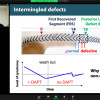
Biology Seminar by Dr. Koichiro Uriu on January 7, 2021
On January 7th, Dr. Koichiro Uriu gave a talk on one of the most important pattern formation in our body. Koichiro was an active member of iTHES, and is currently an assistant professor at Kanazawa Univ. Rhythmic (ON and OFF) and also spatial gene activity pattern, termed the segmentation clock underlies our body axis segmentation (“Taisetsu" in Japanese). Thus, robust gene activity oscillation propagates from the backward to the forward domain by which the segment is formed sequentially. In the seminar, Koichiro discussed the recovery processes of the segment formation after the removal of the drug which blocks oscillator coupling in a fish, called zebrafish. Curiously, experiments show that intermingled segments can occur in the body of the fish especially when the drug is removed at early stage. To understand the pattern recovery, he developed a physical model incorporating mechanics and genetic oscillations. During and after the talk, there were numerous questions from the audience because his talk was very interesting and also very clear. Thank you and see you, Koichiro! - Gen Kurosawa
-
2021-01-20
セミナーレポート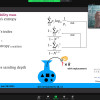
Information Theory SG by Dr. Ryosuke Iritani on January 20, 2021
On January 20th, Dr. Ryosuke Iritani gave us a talk about his motivation to work with information theory. He first formulated the dynamics of species-site data in ecology as a Markov model. By reducing the model to a simpler one in an elegant way, he analytically obtained the evolution of the proportion of species. In addition, he discussed certain entropies that characterize the diversity of species and showed us the unique dynamics of the entropy in his model. His talk was clear as he explained mathematical concepts by using simple examples and illustrations, and there were questions and comments from several viewpoints. We are thankful to Ryosuke for the exciting talk! Kyosuke Adachi (BDR/iTHEMS)
-
2021-01-19
セミナーレポート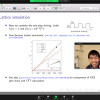
First Quantum Matter Seminar by Dr. Xueda Wen on January 18, 2021
We are happy to invite Dr. Xueda Wen from Harvard University to give a talk on January 18th. This talk is the first seminar of the quantum matter study group. The topic is time-dependent driven quantum critical systems in (1+1) dimensions, which connects condensed matter physics and high energy physics. Dr. Wen started with two different free-fermion lattice Hamiltonians. The system is driven periodically and alternatively with these two Hamiltonians. Interestingly, this driven system leads to two distinct two phases. This straightforward introduction smoothly brought us to the study of time-dependent driven conformal field theories. The driven CFTs show that the periodical driving systems can possess heating and non-heating phases, and the phase transition boundary separates these two phases. Dr. Wen further talked about the generalization of driving CFTs and several unsolved problems. This talk is informative as well as interactive. Drs. Tada, Hongo, and Takasan asked several key questions, and Dr. Wen answered those questions clearly and informatively. We thank Dr. Wen for the great talk. Reported by Ching-Kai Chiu
-
2021-01-15
ホットトピック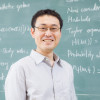
小澤准教授のインタビュー記事がイスラエルの雑誌「Epoch」に掲載
AIMRジュニア主任研究者の小澤知己准教授のインタビュー記事が、イスラエルの一般向け雑誌「Epoch」の2020年12月号に掲載されました。 記事では、小澤准教授が進めている「人工次元」に関する研究が詳しく紹介されています。私たちは3次元空間に住んでいますが、最近通常の次元とは違って人工的に次元に相当するものを作り出し、それに関する実験・研究ができるようになってきました。 小澤准教授は原子のふるまいであるスピンを例に挙げて説明しています。スピンが取る状態を次元とみなせば、4次元量子ホール効果など高次元空間に関する物理現象などを実験的に研究できるようになるとの見解を述べています。 記事は高次元に関する最新の研究を、SFのような並行宇宙(パラレル・ユニバース)などとも関連させて解説した一般向けの内容ですが、人工次元という新しい概念もわかりやすく解説されており、非常に興味深い内容となっています。人工次元に関する研究が物性物理から素粒子物理まで様々な分野に影響を与えることが期待されます。
-
2021-01-14
今週の論文Week 3 of January
Title: A note on exotic families of 4-manifolds Author: Tsuyoshi Kato, Hokuto Konno, Nobuhiro Nakamura arXiv: http://arxiv.org/abs/2101.00367v1 Title: Local Operator Entanglement in Spin Chains Author: Eric Mascot, Masahiro Nozaki, Masaki Tezuka arXiv: http://arxiv.org/abs/2012.14609v1 Title: Chiral separation effect catalyzed by heavy impurities Author: Daiki Suenaga, Yasufumi Araki, Kei Suzuki, Shigehiro Yasui arXiv: http://arxiv.org/abs/2012.15173v1 Title: Tensor-force effects on shell-structure evolution in N = 82 isotones and Z = 50 isotopes in the relativistic Hartree-Fock theory Author: Zhiheng Wang, Tomoya Naito, Haozhao Liang arXiv: http://arxiv.org/abs/2012.13143v1 Title: Second order chiral kinetic theory under gravity and antiparallel charge-energy flow Author: Tomoya Hayata, Yoshimasa Hidaka, Kazuya Mameda arXiv: http://arxiv.org/abs/2012.12494v1 Title: Exceptional Dynamical Phase Transitions in Periodically Driven Quantum Systems Author: Ryusuke Hamazaki arXiv: http://arxiv.org/abs/2012.11822v1 Title: Fermion doubling theorems in 2D non-Hermitian systems for Fermi points and exceptional points Author: Zhesen Yang, A. P. Schnyder, Jiangping Hu, Ching-Kai Chiu arXiv: http://arxiv.org/abs/1912.02788v3
-
2021-01-14
セミナーレポート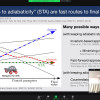
Information Theory SG by Dr. Kyosuke Adachi on January 13, 2021
On January 13, Dr. Kyosuke Adachi gave a talk entitled “Accelerated equilibration in classical stochastic systems” at the journal club of information theory study group. First, he reviewed the concept of shortcuts to adiabaticity (STA) and discussed a two-level system as a concrete example. Then it was explained that STA are fast routes to the final states in quantum systems. Second, he introduced the engineered swift equilibration (ESE) in classical stochastic systems, which is a classical counterpart of STA. Indeed, he explained that the Fokker-Plank equation has a similar structure to the Schroedinger equation, and the fast routes from the initial equilibrium state to the final equilibrium state are ESE. As examples of ESE, compression of Brownian particles, and evolutionary systems were given. Finally, he mentioned some interesting questions. The talk had many stimulating discussions. We are grateful to Adachi-san for his excellent talk!
-
2021-01-14
セミナーレポート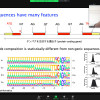
Biology Seminar by Dr. Jeffrey Fawcett on January 14, 2021
In iTHEMS biology seminar on January 14, Jeffery Fawcett (RIKEN iTHEMS) gave us a talk on what genes are and how we can identify them. He started from the basics such as chromosomes, genes, and how proteins are produced from them. He then explained difficulties in defining a gene. This sounds very interesting because most of us (at least, I) naively think that we know what a gene is, even without knowing a precise definition of it. He also explained how we can predict the location of genes on the chromosomes. Jeff nicely presented keys ideas for non-experts, and all of us enjoyed his talk. I am also working on evolutionary biology, but I have never thought seriously about how genes are identified, and his talk became a nice introduction to this fascinating topic. Thank you very much, Jeff! - Takashi Okada
-
2021-01-13
リサーチニュース
RIKEN NEWS: 30秒ごとに更新するゲリラ豪雨予報
局所的・突発的に猛烈な雨が降り、冠水や停電を引き起こすなど、日常生活を脅かすゲリラ豪雨が社会問題化して久しい。しかし、現在の天気予報の技術では、ゲリラ豪雨の発生を予測できない。計算科学研究センターデータ同化研究チームの三好建正チームリーダー(TL)は、30秒ごとに観測データを取り込んで更新する革新的な天気予報手法を開発し、ゲリラ豪雨予報を実現しようとしている。
243件のニュース / 2021年
